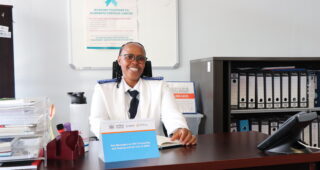Opinion: Biden’s PEPFAR could create the first AIDS-free generation
Dr. Anthony Fauci signaled renewed urgency in a statement at last week’s World Health Organization executive board meeting resulting in a sigh of relief across the global health community. “The Biden Administration … intends to be fully engaged in advancing global health, supporting global health security and the Global Health Security Agenda, and building a healthier future for all people.”
For decades, the U.S. had been a leader in global health investment and innovation. With the inauguration of President Joe Biden, our country stands poised to retake its leadership position, reenergizing diplomatic efforts and partnership building at a time that could not be more critical for global health.
We are beginning to get a clearer picture of what U.S. foreign engagement could look like over the next four years since the confirmation of Tony Blinken to the Department of State and Samantha Power’s nomination to head USAID. Both have extensive experience and view investment in global health and development as vital to foreign policy success.
Now we should turn our focus to the appointment of the new global AIDS coordinator to lead the President’s Emergency Plan for AIDS Relief. The transformational, bipartisan success of PEPFAR makes it an ideal cornerstone on which the Biden administration can reinvigorate relationships, particularly in sub-Saharan Africa, and restore America’s global standing, strengthening diplomatic bonds with strategic allies.
Paramount to PEPFAR’s success in combining public health and diplomacy is its whole-of-government approach through its perch at the State Department. This congressionally mandated structure has harnessed the clinical and development expertise of key government agencies into historic diplomacy-driven public health victories and a leader in epidemic response.
The coordinator must be prepared to reestablish the program’s global impact by tackling the health crises at hand, charting a new direction fighting the dual pandemics of COVID-19 and HIV/AIDS.
While the focus of PEPFAR remains reaching major targets in the fight to end AIDS — as it should — it is crucial that this approach is balanced with an understanding of those closest to the challenges.
Rather than building a COVID-19 response from the ground up, PEPFAR can provide a strong foundation for rolling out COVID-19 mitigation activities while advancing ongoing HIV programming. PEPFAR’s coordinator should leverage the institution’s wide reach for quick action, as the program’s assets — diagnosis, contact tracing, training front-line health care workers, distributing essential medicines like the new vaccine — are vital for an effective COVID-19 response. At the same time, sufficient resources are necessary to accomplish these goals and reduce negative impacts on already strained programs.
Additionally, by incorporating COVID-19 interventions into existing HIV programs, PEPFAR can help recover AIDS progress lost during extraordinary pandemic-related disruptions of health facility-based services. In our own work, the Elizabeth Glaser Pediatric AIDS Foundation has seen fewer women attending antenatal care, leading to decreases in HIV testing for pregnant women by up to 30% in some countries.
Here are three priority steps to halt the second-class care faced by children with HIV.
HIV testing for all ages decreased by 37% across EGPAF programs during the first half of 2020, and regular stock outs of key commodities are occurring across EGPAF-supported countries, including pediatric HIV treatments.
A visionary leader at PEPFAR will prioritize global coordination, enhancing relationships with African leaders and international stakeholders. To instill a country-led vision of operational excellence, the coordinator must understand the day-to-day realities felt by implementing partners who integrate policies and enact strategies.
While the focus of PEPFAR remains reaching major targets in the fight to end AIDS — as it should — it is crucial that this approach is balanced with an understanding of those closest to the challenges.
Finally, the incoming PEPFAR leader must elevate pediatric HIV/AIDS in the comprehensive agenda, recognizing that ending pediatric AIDS is paramount to ending the epidemic itself. Children were all but absent in the latest PEPFAR strategy, and they continue to lag behind adults by almost every measure.
There are nearly 500 new HIV infections in children per day worldwide, and almost half of HIV-positive children are not receiving the lifesaving treatment they urgently need. PEPFAR’s origins are rooted in the moral responsibility to save lives — increasing U.S. investment in eliminating mother-to-child transmission is an indispensable opportunity for enacting that mandate. With 90% of children living with HIV located in Africa, fulfilling the promise of ending pediatric AIDS will be a seismic victory with an impact felt around the world.
In addition to providing pregnant women with treatment, eliminating mother-to-child transmission requires HIV testing and support for adolescent girls and young women and prevention of unintended pregnancies, advancing Biden’s call to “restore a government-wide focus on lifting up women and girls around the world.”
PEPFAR’s extraordinary achievements — the largest commitment by any nation to address a single disease in history — are remarkable. Yet, in the midst of a new pandemic, it is clear: We must do more.
As we begin this new era of U.S. political leadership, the Biden/Harris administration has a historic opportunity to reinvigorate global health programs whose achievements will be decided by the strength of our leader’s visions and the commitment of their investment — and in doing so, create the first ever AIDS-free generation.
This piece was originally posted on Devex here.
Chip Lyons
Global
Pediatric HIV Diagnosis, Care & Treatment; Policy & Advocacy; Prevention of Mother-to-Child Transmission



